The first time I had my friends over for dinner I prepared my signature sheet pan roasted chicken.
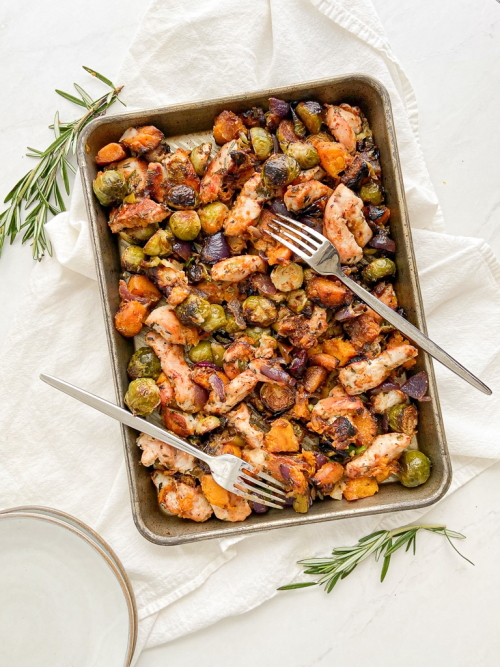 Try this for dinner tonight: Sheet Pan Harvest Chicken
Try this for dinner tonight: Sheet Pan Harvest Chicken
They very impressed with the recipe, but not so much with my strategy for cleaning my sheet pan- let it soak overnight.
Which quickly became overnights.
No, I didn’t expect anyone to clean it for me. I just didn’t know of a better way. Mom and Dad always said elbow grease gets the job done, but the teenager that hasn’t grown up in me thinks there has to be a better way.
Well, it turns out there are easier (and harmless) methods to clean a sheet pan than elbow grease. But the old overnight soak is not really one of them. The secret is making chemicals and chemistry do the work for you.
By chemicals I don’t mean oven cleaning products, which are usually not food safe and can damage aluminum sheet pans. The chemicals I found most useful are water (H2O), baking soda (NaHCO₃) and hydrogen peroxide (H2O2), all of which are food safe, affordable, and useful for cleaning more than just sheet pans.
Let’s start with a minimalist method.
The Boiling Water Method: Suitable For Easy Jobs
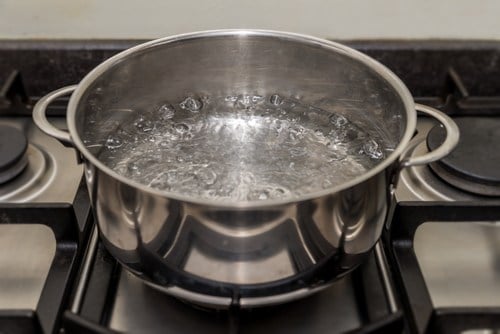
Leaving a pan to soak in hot water overnight can loosen up some of the gunk, but only so long as the water stays warm. By the time your inner teenager (or outer teenager for especially lucky parents) gets around to cleaning the sheet pan, a lot of the gunk will have cooled and solidified to the surface, which will make it even harder to get off later.
If you want to use nothing but water, make it hot water. This will liquify any fats or oils that are stuck to the pan and make them slide right off.
It also helps to salt your water before boiling, as the salt water will do a better job of agitating and cleaning the debris – much like the ocean does to your skin.
Directions
1. Sprinkle the sheet pan with a generous amount of salt (two tablespoons of baking soda also works great).
2. Pour water to cover the sheet pan and bring to a boil by putting it in the oven at 225 degrees Fahrenheit. You do not need to preheat the oven, just be sure to turn off the heat once the water boils. Remove after half an hour, at which point you can dump the water and scrub with a sponge, aluminum foil, or other dish cleaner.
Alternatively:
1. Boil salted water.
2. Pour it over the pan (being careful not to pour it too quickly or you might splash yourself – not that I would know what that feels like) and let sit for up to two hours before scraping with a sponge or aluminum foil.
For smaller pans that fit on your stove burner:
1. Sprinkle salt or baking soda on the surface of the pan.
2. Cover with water and bring to a boil
3. Turn off heat and let sit for 30 minutes before cleaning.
This method worked well for a nonstick sheet pan that I had used to roast a chicken. The first time I used the sheet pan, I was roasting potatoes in vegetable oil directly on the surface and a regular wash with hot water was enough to clean it. With the chicken there was more fat dripping from the rack, plus caramelized spices (onion and garlic powder) caked on to the bottom. I think the boiling water method worked so well in this instance because I didn’t wait too long after dinner to clean the sheet pan. It was at room temperature at this point and I gave it a brief pre-wash before applying the hot water.
This method is more apt for recent messes. If you’re hoping to clean or salvage an older, hopeless-looking sheet pan, the boiling hot water method will probably not be enough. It’s time to bring in backup.
Baking Soda and Vinegar/Lemon Juice: Too Weak to Clean With
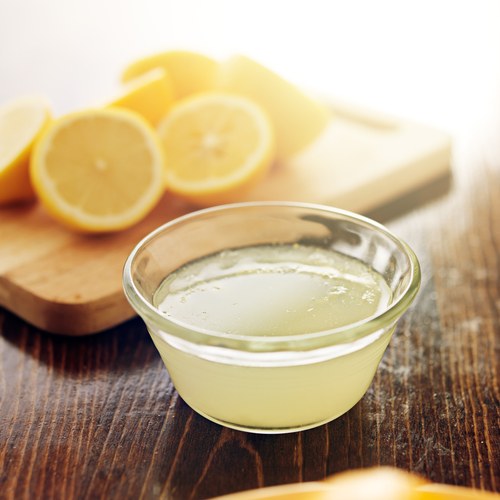
I first thought of baking soda and vinegar, but after doing some research I realized why it doesn’t work for cleaning as well as it does science fair volcanoes.
It turns out the trademark fizzy reaction is just smoke and mirrors. Mixing baking soda and vinegar is not very effective for cleaning because the two elements cancel each other out and leave you with what is essentially salt water.
That said, baking soda on its own makes a good scouring agent. If you leave baking soda on the dish pan without vinegar, and then come back to scrub it later, that will make it easier to knock some of the debris off the surface.
Similarly, baking soda and lemon juice doesn’t come in handy for cleaning dishes. In fact, some people use the combination as a face wash, so while it’s soft on hands, it’s not tough on grease. Let’s move on to the real backup plan
Deep Clean: Break Out Hydrogen Peroxide
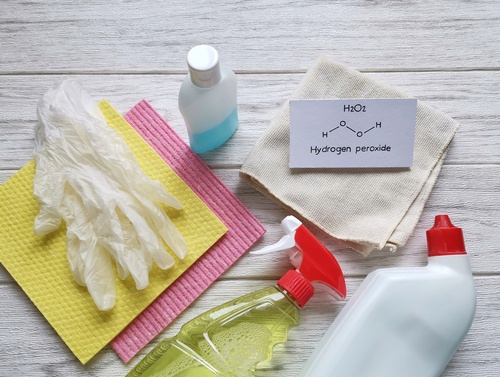
Hydrogen peroxide is commonly used as a disinfectant both for medical equipment and wounds. You can find it in most grocery stores and pharmacies near first aid supplies, and it makes an excellent household cleaning agent, especially when combined with baking soda.
Directions
1. Sprinkle a layer of baking soda on your baking sheet.
2. Drizzle a layer of hydrogen peroxide (enough to barely cover the surface) followed by another layer of baking soda.
3. Let it sit for two hours and then wipe it clean.
While these compounds are generally harmless, they may irritate those with sensitive skin, so consider wearing gloves or using a dish scrubber
It’s also best to store these chemicals separately and only combine them for when you’re using them. If you mix and store baking soda with hydrogen peroxide, over the course of a few days carbon dioxide will build up in the container and eventually cause it to explode like a shaken-up soda bottle.
DO NOT MIX HYDROGEN PEROXIDE WITH VINEGAR
While vinegar and hydrogen peroxide are harmless on their own, like water and electricity it is dangerous to mix them. Doing so creates peracetic acid, which can harm your skin and damage surfaces. If you use both as cleaning products around the house, there’s nothing really to worry about–you just don’t want to put both liquids on the same surface at the same time, and especially not in the same container. Doing so can increase the concentration of peracetic acid and thus make it more harmful.
The Foil or Steel Wool Method
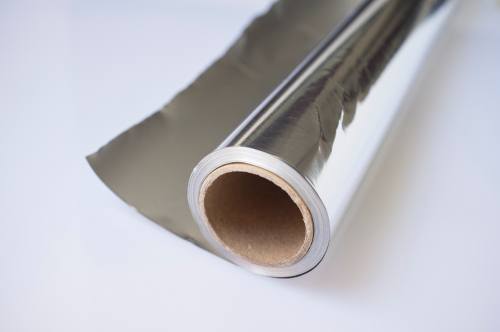
Growing up, I was armed with a brillo pad and elbow grease and sometimes even a fluff of steel wool, which I was only to use on dishes without a nonstick surface. If you don’t have steel wool or a brillo pad on hand, or if you just want to try something different, a ball of aluminum foil might do you well–just make sure you’re using it on a nonstick aluminum surface.
Aluminum on aluminum action will not scratch your sheet pan, but it may do a great job of knocking off any food crusties that have hardened into immovable rocks. I was surprised at how effective this was, but I had to use a lot of foil to create a large enough sponge.
If your mission is to knock some food rocks around, I’d recommend punching the sheet pan with foil after letting it sit for an hour or two in a dusting of baking soda before you attack it with liquids. Once you get the big chunks off, there might be smaller pieces that are hard to reach with your hands but a small enough job for the chemicals to handle.
Aluminum Method
1. Make a ball of foil the size of your fist.
2. Use it to scrape crusty bits off the pan.
3. You can also use hot water, soap and or baking soda with this method. If you do, wear gloves to avoid skin irritation.
When To Say Goodbye to Your Sheet Pan
If these methods still don’t work to clean your sheet pan, my last resort would never be to use potentially harmful chemicals like oven cleaners, which often contain the same chemicals used to clean car engines. There are more sheet pans where yours came from, and the recycling centers probably won’t notice a miniscule amount of food crust when they’re chucking an old sheet pan into a furnace that can melt metal.
Some people swear by those oven cleaners and say they’ve been using them for years without problems, but just because there’s no noticeable or immediate danger to your sheet pan doesn’t mean it’s harmless to expose your food to those chemicals which can hide in the invisible crevices of the sheet pan. I feel much safer working with cleaning agents I can also use to brush my teeth with. And for any after-dinner clean, they get the job done just fine.
Now that you know how to clean your sheet pans, get cooking with these 5 easy and delicious sheet pan dinner recipes!





